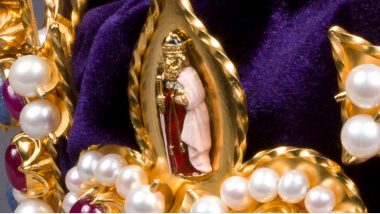 The gold figurine, valued at roughly £2 million, depicts 15th-century English king Henry VI.
The gold figurine, valued at roughly £2 million, depicts 15th-century English king Henry VI.
When classic car restorer and metal detecting enthusiast Kevin Duckett spotted a glint of gold peeking out beneath the soil of an English field , he initially thought he’d found a crumpled piece of foil. But as the Northamptonshire native continued digging, he soon realized he’d stumbled onto something far more valuable.
“The rush of adrenaline and the buzz of excitement started to flow through my body,” Duckett tells the Sun’s Paul Sims. “I was holding what appeared to be a heavy solid gold and enameled figurine.”
Standing just 2.5 inches tall, the statuette may have once formed the centerpiece of a dazzling Tudor crown. As historian Leanda de Lisle wrote on her website this past December, researchers had long thought that the diadem—worn by Henry VIII during processions marking the Feast of the Epiphany and by his five immediate successors during their respective coronations—was lost, its precious metals melted down to make coins and its jewels sold piecemeal following the fall of the British monarchy in 1649. But Duckett’s find is poised to upend this history, suggesting that the artifact, which depicts 15th-century king Henry VI, escaped the wrath of Oliver Cromwell’s anti-royalist Parliamentarians largely by chance.
Speaking with Tom Mack of local news outlet Leicestershire Live, Duckett points out that the field where he found the figurine is near the site of the Battle of Naseby, a June 1645 clash that ended in soon-to-be deposed king Charles I’s devastating defeat at the hands .
Duckett first learned of the potential connection between his find and the lost crown last year, when he watched a YouTube video spotlighting Historic Royal Palaces’ (HRP) creation of a replica headpiece, reports Richard Pendlebury for the Daily Mail. After traveling to Hampton Court Palace to view the copy—based largely on Daniel Myten’s 1631 portrait of Charles—in person, he found himself face-to-face with his “figurine’s identical twin.”(An enormous estate on the outskirts of London, Hampton Court was one of Henry VIII’s favorite palaces, boasting a royal tennis court, lush gardens and a kitchen equipped to feed upward of 800 guests.)
Court inventories indicate that 344 rubies, sapphires, emeralds, diamonds and pearls adorned the crown, which sported miniature sculptures of the Virgin and Child and Saint George, as well as royal saints Edmund, Edward the Confessor and Henry VI, according to HRP. Though the crown originally featured three depictions of Christ in place of the three kings, Henry VIII had the figurines swapped out amid the iconoclasm of the English Reformation.
15th and early to mid-16th centuries viewed him as an unofficial saint and martyr—a trend that accounts for Henry VIII’s eventual inclusion of him in the crown’s cast of characters.
Given Henry VI’s decline in stature and the obvious perils associated with bringing a royal relic into battle, exactly how the newly rediscovered figurine ended up in Northamptonshire remains unclear. But de Lisle, author of White King: The Tragedy of Charles I, tells the Daily Mail that Charles may have drawn on it as a source of hope.
“Henry VI supposedly had once appeared in a miracle to save an innocent man from a hanging,” she says. “Did Charles hope for some kind of similar intervention?”
The petite gold statue is currently being held at the British Museum in London for safekeeping and assessment. If confirmed as a missing piece of the Tudor crown, Duckett and the owner of the land where the artifact was found may be eligible to receive a portion of the proceeds from its sale to a museum. Per the Sun, the figurine is worth an estimated £2 million, or $2.7 million.
“It’s great news that after centuries of subterranean slumber this little golden figure has been revealed once more,” Lucy Worsley, chief curator at HRP, tells the Sun. “It is tantalizing to imagine its true history.”
